|
A glimpse into the past...
KEOTA POST OFFICE
DEPARTMENT
The
Keota Post
Office was established in March 1872. Hon. John Wilson was appointed
Post Master. His salary for the first four months was $1.00 per month.
His salary for the year ending July 1, 1876, was over $900. Office was
made a money order office July 1, 1874. The first money order was
issued July 7, l874, by Isaac Tomas, Richland, Iowa, to C. W. Stevens,
Chicago, Ill. In the space of two years the number has exceeded 2500.
To show the amount of business transacted by this office, it will only
be necessary to state that the amount of money transmitted by postal
orders alone this year (1880) approximate the sum of $30,000.
May
5, 1883.
After July 1 the mail will be carried tri-weekly from Dublin to Keota
(via Paris and Talleyrand) and return.
Jan.
30, 1886.
The post office too has been removed to the bank building and is now in
charge of Dr. Brice, Vice Uncle Johnny Wilson. The old post office
location is now a blank.
May
23, 1890.
There were 1983 pieces of mail mailed at Keota post office between May
5th and 12th.
April
l, 1898.
After April 4th, the Keota Post Office will be made an international
money order office. Postmaster Newton received notice from Washington
last week. The amount of business transacted here warrants the change.
May
20, 1898.
Charley Dayton is the author of an ingenious scheme for a rural mail
delivery out his way once per diem. By cooperating with Postmaster
Newton and the train boys he has a bunch of mail sacked up in the Keota
Post Office every day and the news agent obligingly drops it into his
yard as the express whistles by. Others have joined in the plan. It
costs them but 10¢ per month each to have the mail thus delivered to
them daily. It is very convenient for our farmer friends, especially
while the war excitement is on.
May
18, 1902.
Postmaster L. E. Hulse received word from authorities that a rural
delivery route running north will be established July 1. It will be
known as Route No. l.
June
12, 1902.
The Post Office Department authorizes a free delivery mail service from
this office to commence Tuesday, July 1, with Charles O. Harris as
carrier. The length of the route is 24 1/4 miles and serves a
population of 536. Carrier will leave post office at 11 a.rn. and
return with his collection by 4 to 4:30 p.m. The carrier will carry a
supply of postage stamps, postal cards, stamped envelopes, and money
order blanks, also receipts for matter to be registered. Boxes along
route must be of pattern approved by Dept. or they will not be served
by carrier. The boxes must be erected near highway so carrier can reach
them to deposit or collect mail without dismounting from his vehicle.
Three large iron collection boxes will be placed—one at Ed Randolph
corner, one at Peter Stein School House corner, and one at Center
Church and school center.
Del
Reed has been
chosen as deputy or substitute carrier. Charley will get a saIary of
$600 a year.
Jan.
4, 1906. The
firefly mail service is assured. A trial trip was made Tuesday. Chief
Hughes of Burlington had charge that day until the regular mail clerk
arrives. It will service all towns between Oskaloosa and Columbus
Junction. We now get full mail service east and west twice a day.
May
26, 1910.
There are four Keota post offices in the United States: Colorado,
Missouri, Iowa and Oklahoma.
Jan.
1, 1914.
MAIL. During the first four days of last week the local post office
handled 83 tie sacks of mail.
Aug.
6, 1914.
Rural Mail Carriers all received $1100 except No. 5 who received $1056.
The new raise follows:
C.
O. Harris,
$1164; Delmer Reed, $1176; J. A. L. Schreckengast, $1152; E. G.
Warrington, $1116; A. W. Swift, $1068.
May
26, 1936.
Five hundred thirty-one letters were sent on airmail flight from Keota
Thursday afternoon. Airmail pilot T. Edward Peiffer, commissioned for
the day, brought the plane from Iowa City airport and landed in a field
at Pete Haupert's, a mile west of Keota.
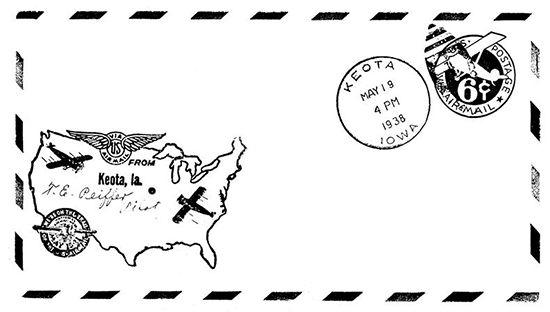
131
A glimpse into the past...
Postmaster J. E.
Leinen took the pouch with the airmail to the field about four o'clock.
A hundred or so persons watched the flight.
Airmail stamps
will be six cents and all letters will be rubber stamped with special
design showing outline map of United States with Keota marked with dot
in proper place.
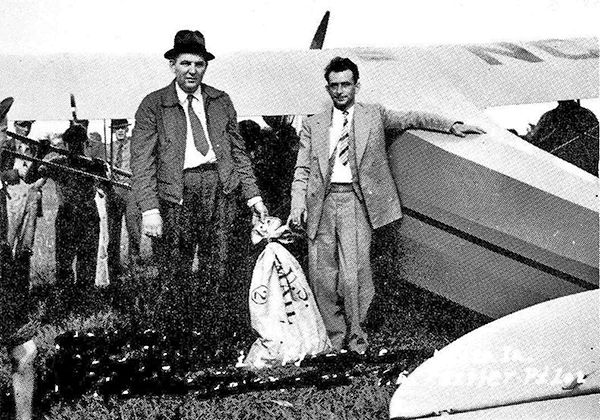
Keota, Keokuk
County, Iowa
Established on
May 13, 1872
| Postmasters |
Dates of
Appointments
Through
September 30, 1971 |
| |
|
| John F. Wilson |
May 13, 1872 |
| R. S. Brice |
July 31, 1885 |
| Finley M. Smock |
March 25, 1889 |
| Miss Louie B. Stewart (name changed by marriage
to Mrs. Louie B. Harter, April 27, 1894) |
April 15, 1893 |
| Hanno P. Newton |
April 28, 1897 |
| Lauren E. Hulse |
March 1, 1902 |
| George H. Helscher |
March 11, 1914 |
| Elmer G. Warrington |
December 30, 1922 |
| John G. Ranous |
February 26, 1927 |
| Anson G. Richardson |
April 16, 1934 (acting) |
| John E. Leinen |
August 28, 1934 (acting) |
| Mary H. Greiner |
September 4, 1934 (assumed charge) |
| Robert S. Schreurs |
January 18, 1935 (confirmed) |
| Robert S. Schreurs |
January 14, 1966 (acting) |
| |
December 7, 1967 (confirmed) |
| |
January 13, 1968 (assumed charge) |
| The records show the date of
appointment of the postmasters, but not the tenure of their service. |
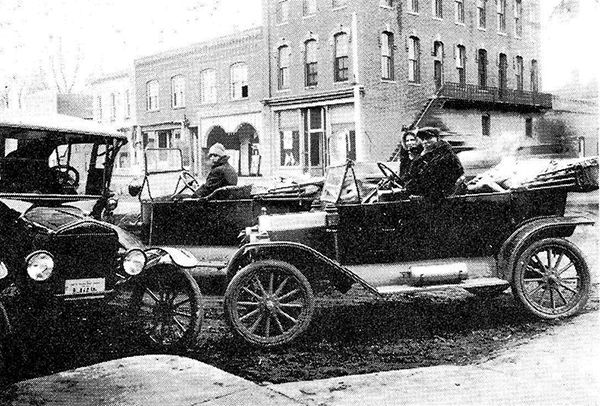
Rural mail carriers, ready to go on route. Logan (Cy) Schreckengast,
in center car —
Mr. and Mrs. Chas. Harris in car to the right
in picture. P.O. was then located at loca-
tion of the Laundromat as
of 1973. Keota's first P.O. was located approximately one door
W. of the theater in the above picture or where the Watts Motor Co.
is now located.

Keota Post Office
January 21, 1960.
Keota's new $35,000 Post Office will officially open January 25th. The
new building is directly across from The Eagle Office. It will have 355
boxes, is air conditioned and has the newest design in indirect
lighting.
This is the first
move in 25 years for the Post Office, having been at the corner
location of Broadway and Fulton that long.
132
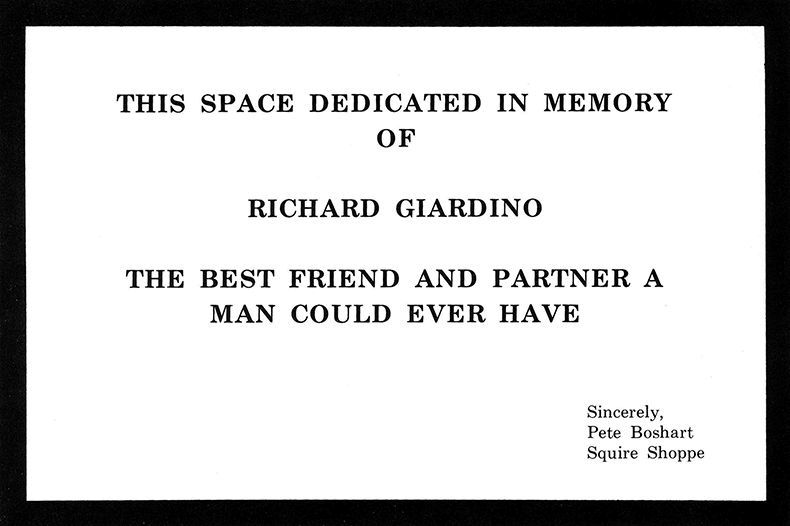
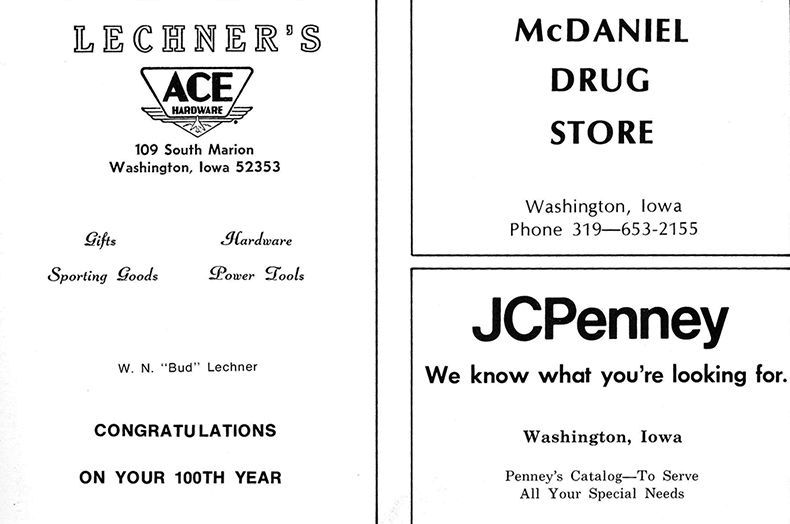
133
CENTENNIAL PLANNING
134
CENTENNIAL PLANNING
135
A glimpse into the
past...
COAL IN KEOTA?
COAL COMPANY
FORMED
June 16, 1883.
Our coal prospectors have been here several days and on Thursday set up
machinery on the open lot on the south side of Broadway between Clark's
Implement store and Norton's flour house. The hole is being bored just
in the edge of the street. They struck rock and considerable sand so
pulled up and moved west opposite the Schreckengast store.
August 11, 1883.
The coal prospectors have reached a depth of 210 feet. The last 15 feet
was a light colored shale. Prospects for finding coal are better than
ever. The coal prospectors quit boring Monday. They have reached a
depth of 317 feet and refuse to work any longer for less than $25.00 a
day. The coal committee let them depart; even though the shale became
darker as the depth increased.
May 6, 1887. It
seems strange with as much enterprise as Keota is noted for that an
effort has not been made before this to raise funds to continue the
work of boring for coal that was begun something like two years ago.
The hole as we understand the matter is now down something near 300
feet with the tubing all in and ready to continue the work without
further trouble, and with sufficient funds to start anew, there is no
doubt the effort would be successful. We believe when work was
discontinued the drill was in solid blue limestone and had been for
some 50 feet. It is possible this stone is celebrated Trenton limestone
that is said to overlay natural gas. It seems probable that drilling
through this we might strike a good vein of coal or natural gas.
May 5, 1904.
Prospecting for coal north west of Keota was begun yesterday by Arch
Stewart and son George. The Keota company has leased 700 acres of land
from farmers: A. H. Brown; J. P. Cook; David F. Coffman; Walter Teable
and Dexter Saxon.
The Keota parties
furnishing company are: B. L. Sanders; V. W. Carris; J. Warren Stewart;
W. A. Stewart; A. Stewart; J. F. Romine; and E. E. Bower. Parties
drilling deep wells on some of these farms have found good veins of
coal. Whether it can be mined and put on paying basis will soon be
determined.
June 9, 1904. The
Keota Coal Company was formally organized with these officers.
President- V. W. Carris; Secretary- E. E. Bower; Treasurer- Walter
Stewart. The object is to develop coal fields in the Scotland
neighborhood. Six holes have been sunk and coal found in each one of
them. An expert from Rose Hill has been hired to superintend the work.
KEOTA CEMETERY
The Keota
Cemetery consisting of six acres, 1/2 mile north of town on the south
bank of Crooked Creek, was surveyed and laid out in 1872. It belongs to
the Town of Keota.
June 17, 1876.
The first monument in the Keota Cemetery is by H. A. Milhouse for
little Frankie who died in 1875.
October 20, 1883.
Why don't we have a hearse in Keota? We need a respectable vehicle to
convey the dead to their last resting place. A hearse is needed here,
with due regard to our self respect as a town, and, the respect we owe
our departed friends and neighbors who die before we do, demand that
one be provided. Let us no longer use an old platform wagon, but give
them respectable transportation to our beautiful cemetery on the hill.
May 31, 1889.
There is no better kept cemetery in this part of the state than the one
in Koeta [sic]. Can you imagine a prettier location, a grassy knoll
gently in all directions, well fenced, the center covered with
beautiful white marble stones and monuments of different colors that
mark the place of loved ones. The well kept graves, the evergreens and
the bloom of many different flowers planted there by friends, show that
though dead, they are not forgotten.
March 20, 1908.
The Town Council met and voted to buy two acres of ground from W. R.
Charlton for a cemetery for $700. The ground joins the old cemetery on
the south and has been surveyed and platted into cemetery lots. The new
plat consists of 40 lots 20 feet square and 60 lots 9 x 20 feet and are
for sale.
May 27, 1909. Ed.
C. (Shorty) Coffman's fine hearse and rubber tired cabs for funerals.
Prices reasonable — Best of drivers. This cab line will take you to any
part of the city for 25 cents.
May 7, 1914. A
permanent fund for the care of our cemetery has aroused some interest
here.
June 4, 1914. The
fences have been removed between the two cemeteries so that they now
appear as one and vehicles are barred out. In time it ought to be
arranged so that people may drive in and around and through as they can
in all up-to-date cemeteries.
November 16,
1916. The Town of Keota has purchased the fractional five acres of
ground just south of the new addition to the cemetery from Hamilton
Brothers and will incorporate it with the new addition already in use.
The committee on grounds, together with Engineer Walker of Clinton,
have platted the new ground. The price paid was $2,800, about $500 an
acre.

Building sidewalk to cemetery. Old cemetery in the background.
136
A glimpse into the past...
|
June 8,
1933. The control of Keota cemetery will pass from the Town Council to
a board of three trustees after July 1.
November
20, 1969. A chain link fence with a gate was erected at the entrance of
the Keota Cemetery after the proposal by the town council to close the
cemetery during the night time hours because of past vandalism at night
in the cemetery.

|
The Keota Hospital
January 2,
1913. Dr. A. J. Droz and Mr. F. O. Pershing are going to establish a
hospital in 25 x 80 ft. rooms owned by Mrs. M. E. Ritchey, on Broadway,
the front part of which is occupied by C. O. Keiser. Keiser will move
across the hall to rooms now used by Dr. Pershing. The large hall will
be fitted up into 11 rooms, some chambers for patients, consulting
rooms etc. There will be steam heat, toilets and bathrooms.
March 27,
1913. The Keota Hospital opened Monday morning. All the rooms are not
ready nor has all the equipment arrived, but the hospital is ready to
receive patients of either doctor or other physicians. Miss Beulah
Eichelberger is head nurse and Miss May Dorrance is office girl and
bookkeeper. Four rooms are now fitted with everything necessary for the
sick and a special maternity room is to be equipped. There is a
reception room, a library, a laboratory, an operating room, a bathroom
and each physician has a private consulting room. Rooms $15 per week,
including everything.
Miss Lena
Berg was the first patient and was operated on by Dr. Brockman of
Ottumwa.
April 12,
1917. Dr. Pershing has rented the hospital to nurses Misses Wilson of
Oskaloosa and Gilbert of Cedar Rapids for a period of six months. The
nurses came April 20th to take charge of the local hospital. The rooms
have been painted and all will be ready for patients by the end of the
week. The nurses will be on duty at all times, and patients can be
received at any hour of the day or night. All cases will receive the
best care possible.
May 24,
1917. The Keota Hospital is closed. (The location of the hospital was
in the H. Henkle Block, built in 1903, two stories in height on two
lots lying on the North side of Broadway where today is the location of
the Farm & Home Drug Store.)
THE AUTOMOBILE COMES TO KEOTA
April 24,
1902. Keota saw an automobile for the first time Monday and the novel
spectacle set our people agog with curiosity. Work was suspended;
shopkeepers locked their doors to enjoy the great show; women brought
their babes to see the hossless wagon; the butcher, the baker, and the
candlestick maker all put their aprons aside and came to view the
marvelous sight. Intense excitement prevailed. Business was paralyzed.
It will be many days ere this burg recovers from the unwanted
sensation.
August 4,
1904. Dr. A J. Droz has an Oldsmobile run-about. It is a 7 h.p. machine
and cost $650.00. The Oldsmobile is a handsome affair. The auto has
come to stay. Keota has its third gasoline road vehicle.
|
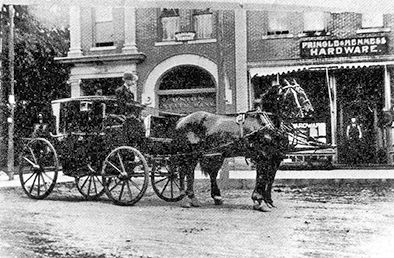
1909. Ed. C. Coffman's fine hearse and
rubber tired cabs for funerals. |
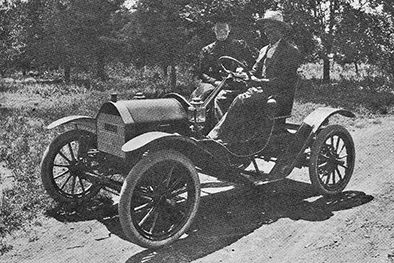
A "Brush" car in Keota. |
137
A glimpse into the past...
August 10, 1905.
Dr. A. J. Droz and Ralph Hamilton intended to go to Ottumwa after the
Doctor's car but at the last moment the Doctor took a notion to trade
his car so went to Davenport and bought a new one. It's a 22 h. p.
geared to speed 45 miles an hour. It's a 4-passenger Buick. They left
at 10:00 and got here at 4:00.
May 10, 1906.
Last year we had three automobiles and this year we've only one and are
standing it all right. An automobile is a nice thing but like the
bicycle they're a passing fad and the sooner it passes the better it
will be for all concerned. They cannot be used more than three months
in the year in this country and are therefore impractical.
Aug. 23, 1906.
This has been a great week for automobiles. 'Pears to be one every half
minute. Frank Kerfoot of Ottumwa has been here all week with a handsome
big machine gotten out by his firm. The Whites, and the same is for
sale at $2800. Don't know which gentlemen likes it the best, S.K.
Leacox or P. Stein. It runs by steam and without doubt is the smoothest
of its kind seen at Keota and it should be at that price. Keisers had a
machine of another make come here and they shipped it on to Texas.
June 25, 1908.
The way automobiles have popped out in sight the last few days reminds
us of chickens popping out of their shells. A week or two ago there
weren't any to speak of and now they go whizzing by every few minutes.
Aug. 6, 1908.
Keota now has 15 automobiles.
September 18,
1909. Lawrence Bohrofen has a new Auburn car, cost $1975.00.
Jan. 14, 1909.
The Studebaker E.M.F. automobile company made a trial trip of one of
their machines through Iowa last week to demonstrate their car over
frozen Iowa roads. E.S. Erdice piloted the car to Oskaloosa. According
to reports, several of the party froze hands and faces at different
stages of the trip, but the machine went through without a break or
halt.
April 8, 1909.
Keota motorists ought to otganize a club and have a parade on the 4th
and do lots of stunts. We had 17 machines here at once last year and
doubtless there will be more this summer. The automobile has come to
stay.
May 27, 1909.
Keota is getting so many automobiles some one will have to learn to
pronounce "garage." It won't do to have so many automobiles in town and
still be unable to produce a man who can properly pronounce "garage."
March 17, 1910.
Bring your wife or sweetheart and have a free auto ride the 19th at
Ralston's Grand Implement and Buggy Opening.
May 12, 1910.
There are 32 different makes of automobiles registered in the State of
Iowa, Ford, Overland, Buick, Reo and Maxwell being the five most
popular.
March 23, 1911.
B.D. Helscher is the first person to run a new automobile on Keota
streets this spring. He has a Cadillac car—30 hp.—1911 model. A little
bird told us it cost eighteen hundred plunks. It sure is a dandy.
Aug. 31, 1911.
STANLEY STEAMER. The editor of The Keota Eagle had a ride in Tom
Singmaster's Stanley Steamer Monday and it is some car. We don't know
anything about autos but the machine is not so complicated but a common
plug can run them with little trouble. There are no magnetos or
carburetors and such, to monkey with. Chet Stewart told us he had to
buy five to get the agency. The way the Stanley can stop dead still at
the bottom of a steep hill and shoot to the top is a caution.
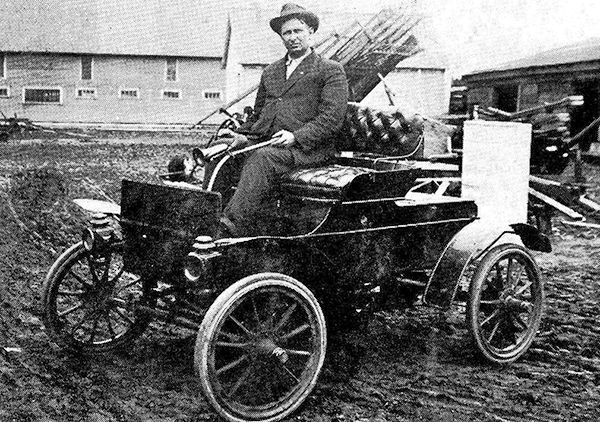
James Ralston and his 1906 "Merry Oldsmobile"
138


139
A glimpse into the past...
QUOTES ABOUT EARLY
CARS, AUTO LAWS
AND
EARLY ROADS
May
16, 1901.
Keota's new road grader has arrived. It works tip-top. Six horses and
four men are required to operate it. Most anything in the way of
shaping, cutting, scraping, or filling can be done with it.
May
18, 1911. NEW
AUTO TAX LAW. July 1, 1911, every automobile in Keota must carry its
number in front and rear. The new auto tax must be paid to Secretary of
State after July 1, and autoists must pay half a year's tax to cover
remainder of this year. Eighty-five percent of money derived from auto
tax will be divided among the different counties with regard to number
of townships in the county. The money must be used for road and bridge
work outside cities and towns.
Under
the new law
the tax on automobiles is $8 a year up to 20 H.P. and 40¢ for each
additional H.P.
September
28,
1911. The river-to-river automobile road from Davenport to Council
Bluffs will go through Keota if present plans materialize. A gentleman
was in town with blueprints, maps, ets., and he said the present plan
is to take in Keota.
Nov.
2, 1911. We
now have the I.O.A. short line through Keota and when the Ottumwa,
Keota, and Iowa City interurban gets going we can get most anywhere.
July
4, 1912.
Keokuk County formed an Auto Association and Good Road Club June 20
with usual officers and a board of directors. The object is to promote
the building and maintenance of good roads.
December
26,
1912. McClure Beats Peterson. The automobile race last Saturday between
D. P. McClure and P. C. Peterson created considerable of a stir. The
race was from Davenport to Council Bluffs and was for the purpose of
testing the merits of the two routes across the state, one of which
goes through Keota and the other 25 miles to the north. McClure was our
man and he beat Peterson into Council Bluffs by about 18 miles
notwithstanding that a leak in the gasoline pipe between West Chester
and Keota delayed him 45 minutes. Naturally the result is pleasing to
us. McClure drove an Oakland, Peterson a Pope-Hartford. The way McClure
tore up the dust going through Keota was a caution — nothing like it
having been seen before. Speed limits were suspended by the different
towns during the race. The various cities will by telephone keep in
touch with the flying cars.
Jan.
2, 1913. The
automobile race last Saturday to test the merits of two routes from
Davenport to Council Bluffs created quite a stir. The one route goes
through Keota and the others 25 miles north. Our man McClure, who drove
an Oakland, beat Petersen, who drove a Pope Hartford, by about 18
miles. The way McClure tore up dust going through Keota was a caution;
nothing like it having been seen before. Speed limits were suspended by
different towns during the race.
May
22, 1913. The
Great White Way is the name of the road across the state from Davenport
to Council Bluffs via Keota. Last year it was known as I.O.A. Short
Line. Instead of going straight west of Oskaloosa it takes in Des
Moines as it should. Keota has a board of five directors to look after
welfare of the Great White Way in this vicinity. They are C. A. Lacey,
A. C. McNurlen, B. D. Helscher, J. M. White and J. C. Richardson.
LATER:
The Auto
Club and I.O.A. Short Line combined into an organizdtion called the
Great White Way Association of lowa. The organization thus affected at
once becomes one of the strongest road agencies in the state. The
promoters claim that the Great White Way is today the best dirt road of
equal length and density of population along the route to be found in
the world. The total length of the Great White Way from Davenport to
Council Bluffs is approximately 330 miles or 20 miles shorter than any
other cross-state road passing through Des Moines. A campaign starts
for a large fund to be raised with which to paint the poles along the
route white — the official marking being a stripe six feet wide and
four feet from the ground.
July
31, 1913.
Some of these new fangled electric head lights on automobiles are so
fierce that drivers of horses meeting them are so blinded they can't
see the road for a couple hundred yards. They light things up for sure.
Aug.
7, 1913. We
took a ride in Chet Stewart's Velie the other night that was not slow.
On the flat by Nic Smith's the speedometer showed 47 miles per hour and
when we went down the Dan Wolfe hill it showed 55. The sensation going
down that hill was about like one experiences when going down a fast
skyscraper elevator for the first time.
August
13, 1914.
Clarence Lacey raised about $40 with which to hire the Great White Way
telephone poles painted in our vicinity. A white band with black border
at top and bottom is the design used.
April
8, 1915.
Keota has agencies for six different automobiles — the Cadillac, Ford,
Overland, Dodge, Studebaker and Velie. Come to Keota if you want a car.
June
24, 1915.
Chet Stewart of Keota won the automobile race at Williamsburg. There
were four entries: Hashner drove a Buick; Dunlap a Saxon Six; McDonough
a Chandler Six; and Stewart a Velie. The distance was three miles.
August
26, 1915.
How to Start Car — It's a good thing to know how to start a car, even
though the crank is lost. Simply jack up one rear wheel, throw the car
in high speed and turn the wheel. Of course, the spark must be in
proper place. As soon as car gets under its own power, put in neutral
before letting down the rear wheel. If this is not done the car will
start forward as soon as the rear wheel touches the ground.
September
9,
1915. Keota has a new automobile hearse. Gus Hochstadler bought it and
it was used for the first time Sunday.
November
11,
1915. Doc McNurlen made the run from Keota to Ottumwa, a distance of 52
miles, in one hour, thirty-five minutes. It may not have been a record
but it was going some.
140
|